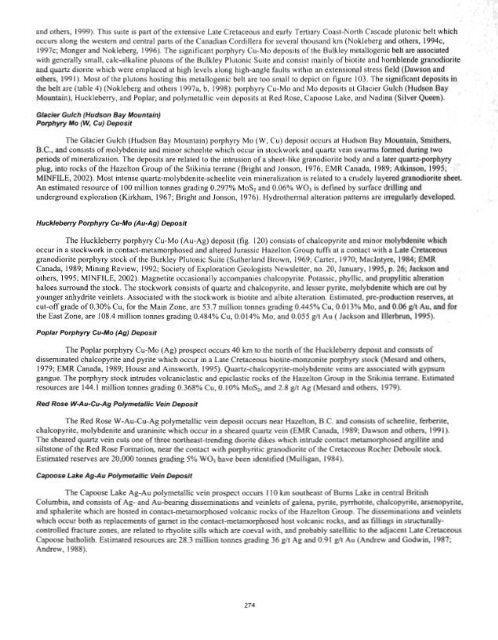Metallogenesis and Tectonics of the Russian Far East, Alaska, and ...
Metallogenesis and Tectonics of the Russian Far East, Alaska, and ...
Metallogenesis and Tectonics of the Russian Far East, Alaska, and ...
Create successful ePaper yourself
Turn your PDF publications into a flip-book with our unique Google optimized e-Paper software.
<strong>and</strong> o<strong>the</strong>rs, 1999). This suite is part <strong>of</strong> <strong>the</strong> extensive Late Cretaceous <strong>and</strong> early Tertiary Coast-North Cascade plutonic belt which<br />
occurs along <strong>the</strong> western <strong>and</strong> central parts <strong>of</strong> <strong>the</strong> Canadian Cordillera for several thous<strong>and</strong> krn (Nokleberg <strong>and</strong> o<strong>the</strong>rs, 1994c,<br />
1997c; Monger <strong>and</strong> Nokleberg, 1996). The significant porphyry Cu-Mo deposits <strong>of</strong> <strong>the</strong> Bukley metallogenic belt are associated<br />
with generally small, calc-alkaline plutons <strong>of</strong> <strong>the</strong> Bulkley Plutonic Suite <strong>and</strong> consist mainly <strong>of</strong> biotite <strong>and</strong> hornblende granodiorite<br />
<strong>and</strong> quartz diorite which were emplaced at high levels along high-angle faults within an extensional stress field (Dawson <strong>and</strong><br />
o<strong>the</strong>rs, 1991). Most <strong>of</strong> <strong>the</strong> plutons hosting this metallogenic belt are too small to depict on figure 103. The significant deposits in<br />
<strong>the</strong> belt are (table 4) (Nokleberg <strong>and</strong> o<strong>the</strong>rs 1997a, b, 1998): porphyry Cu-Mo <strong>and</strong> Mo deposits a1 Glacier Gulch (Hudson Bay<br />
Mountain), Huckleberry, <strong>and</strong> Poplar; <strong>and</strong> polymetallic vein deposits at Red Rose, Capoose Lake, <strong>and</strong> Nadina (Silver Queen).<br />
Glacier Gulch (Hudson Bay Mountain)<br />
Porphyry Mo (W, Cu) Deposit<br />
The Glacier Gulch (Hudson Bay Mountain) porphyry Mo (W, Cu) deposit occurs at Hudson Bay Mountain, Smi<strong>the</strong>rs,<br />
B.C., <strong>and</strong> consists <strong>of</strong> molybdenite <strong>and</strong> minor scheelite which occur in stockwork <strong>and</strong> quartz vein swarms formed during two<br />
periods <strong>of</strong> mineralization. The deposits are related to <strong>the</strong> intrusion <strong>of</strong> a sheet-like granodiorite body <strong>and</strong> a later quartz-porphyry<br />
plug, into rocks <strong>of</strong> <strong>the</strong> Hazelton Group <strong>of</strong> <strong>the</strong> Stikinia terrane (Bright <strong>and</strong> Jonson, 1976; EMR Canada, 1989; Atkinson, 1995;<br />
MINFILE, 2002). Most intense quartz-molybdenite-scheelite vein mineralization is related to a crudely layered granodiorite sheet.<br />
An estimated resource <strong>of</strong> 100 million tonnes grading 0.297% MoSz <strong>and</strong> 0.06% W03 is defined by surface drilling <strong>and</strong><br />
underground exploration (Kirkham, 1967; Bright <strong>and</strong> Jonson, 1976). Hydro<strong>the</strong>rmal alteration patterns are irregularly developed.<br />
Hucklebeny Porphyry Cu-Mo (Au-Ag) Deposit<br />
The Huckleberry porphyry Cu-Mo (Au-Ag) deposit (fig. 120) consists <strong>of</strong> chalcopyrite <strong>and</strong> minor molybdenite which<br />
occur in a stockwork in contact-metamorphosed <strong>and</strong> altered Jurassic Hazelton Group tuffs at a contact with a Late Cretaceous<br />
granodiorite porphyry stock <strong>of</strong> <strong>the</strong> Burkley Plutonic Suite (Su<strong>the</strong>rl<strong>and</strong> Brown, 1969; Carter, 1970; Maclntyre, 1984; EMR<br />
Canada, 1989; Mining Review, 1992; Society <strong>of</strong> Exploration Geologists Newsletter, no. 20, January, 1995, p. 26; Jackson <strong>and</strong><br />
o<strong>the</strong>rs, 1995; MINFILE, 2002). Magnetite occasionally accompanies chalcopyrite. Potassic, phyllic, <strong>and</strong> propylitic alteration<br />
haloes surround <strong>the</strong> stock. The stockwork consists <strong>of</strong> quartz <strong>and</strong> chalcopyrite, <strong>and</strong> lesser pyrite, molybdenite which are cut by<br />
younger anhydrite veinlets. Associated with <strong>the</strong> stockwork is biotite <strong>and</strong> albite alteration. Estimated, pre-production reserves, at<br />
cut-<strong>of</strong>f grade <strong>of</strong> 0.30% Cu, for <strong>the</strong> Main Zone, are 53.7 million tonnes grading 0.445% Cu, 0.013% Mo, <strong>and</strong> 0.06 g/t Au, <strong>and</strong> for<br />
<strong>the</strong> <strong>East</strong> Zone, are 108.4 million tonnes grading 0.484% Cu, 0.014% Mo, <strong>and</strong> 0.055 g/t Au ( Jackson <strong>and</strong> Illerbrun, 1995).<br />
Poplar Porphyry Cu-Mo (Ag) Deposit<br />
The Poplar porphyry Cu-Mo (Ag) prospect occurs 40 krn to <strong>the</strong> north <strong>of</strong> <strong>the</strong> Huckleberry deposit <strong>and</strong> consists <strong>of</strong><br />
disseminated chalcopyrite <strong>and</strong> pyrite which occur in a Late Cretaceous biotite-monzonite porphyry stock (Mesard <strong>and</strong> o<strong>the</strong>rs,<br />
1979; EMR Canada, 1989; House <strong>and</strong> Ainsworth, 1995). Quartz-chalcopyrite-molybdenite veins are associated with gypsum<br />
gangue. The porphyry stock intrudes volcaniclastic <strong>and</strong> epiclastic rocks <strong>of</strong> <strong>the</strong> Hazelton Group in <strong>the</strong> Stikinia terrane. Estimated<br />
resources are 144.1 million tonnes grading 0.368% Cu, 0.10% MoS2, <strong>and</strong> 2.8 g/t Ag (Mesard <strong>and</strong> o<strong>the</strong>rs, 1979).<br />
Red Rose W-Au-CU-Ag Polymetallic Vein Deposit<br />
The Red Rose W-Au-Cu-Ag polymetallic vein deposit occurs near Hazelton, B.C. <strong>and</strong> consists <strong>of</strong> scheelite, ferberite,<br />
chalcopyrite, molybdenite <strong>and</strong> uraninite which occur in a sheared quartz vein (EMR Canada, 1989; Dawson <strong>and</strong> o<strong>the</strong>rs, 199 1).<br />
The sheared quartz vein cuts one <strong>of</strong> three nor<strong>the</strong>ast-trending diorite dikes which intrude contact metamorphosed argillite <strong>and</strong><br />
siltstone <strong>of</strong> <strong>the</strong> Red Rose Formation, near <strong>the</strong> contact with porphyritic granodiorite <strong>of</strong> <strong>the</strong> Cretaceous Rocher Deboule stock.<br />
Estimated reserves are 20,000 tonnes grading 5% W03 have been identified (Mulligan, 1984).<br />
Capoose Lake Ag-AU Polymetallic Vein Deposit<br />
The Capoose Lake Ag-Au polymetallic vein prospect occurs 1 10 km sou<strong>the</strong>ast <strong>of</strong> Burns Lake in central British<br />
Columbia, <strong>and</strong> consists <strong>of</strong> Ag- <strong>and</strong> Au-bearing disseminations <strong>and</strong> veinlets <strong>of</strong> galena, pyrite, pyrrhotite, chalcopyrite, arsenopyrite,<br />
<strong>and</strong> sphalerite which are hosted in contact-metamorphosed volcanic rocks <strong>of</strong> <strong>the</strong> Hazelton Group. The disseminations <strong>and</strong> veinlets<br />
which occur both as replacements <strong>of</strong> garnet in <strong>the</strong> contact-metamorphosed host volcanic rocks, <strong>and</strong> as fillings in structurally-<br />
controlled fracture zones, are related to rhyolite sills which are coeval with, <strong>and</strong> probably satellitic to <strong>the</strong> adjacent Late Cretaceous<br />
Capoose batholith. Estimated resources are 28.3 million tonnes grading 36 g/t Ag <strong>and</strong> 0.91 g/t Au (Andrew <strong>and</strong> Godwin, 1987;<br />
Andrew, 1988).
















